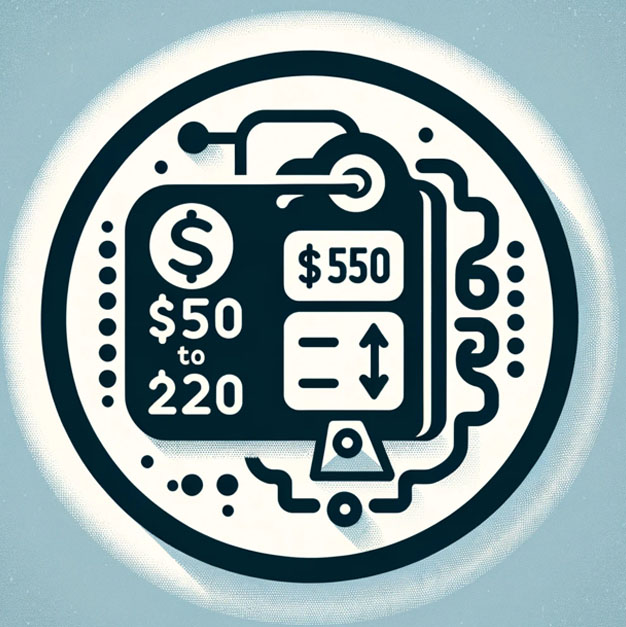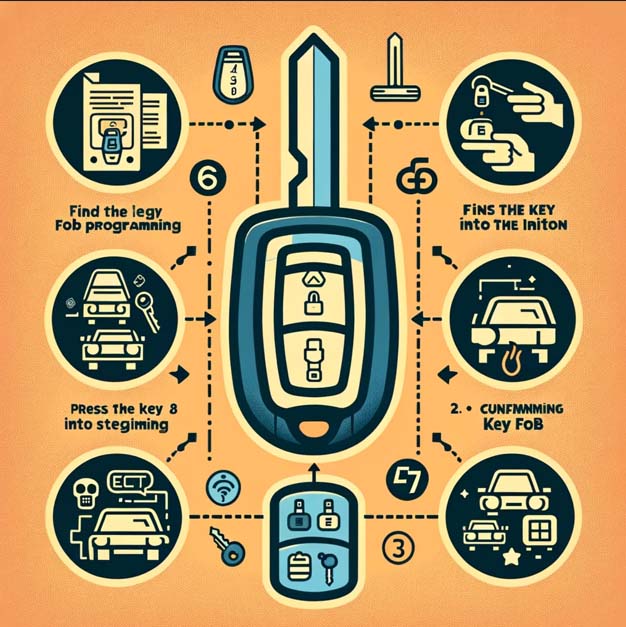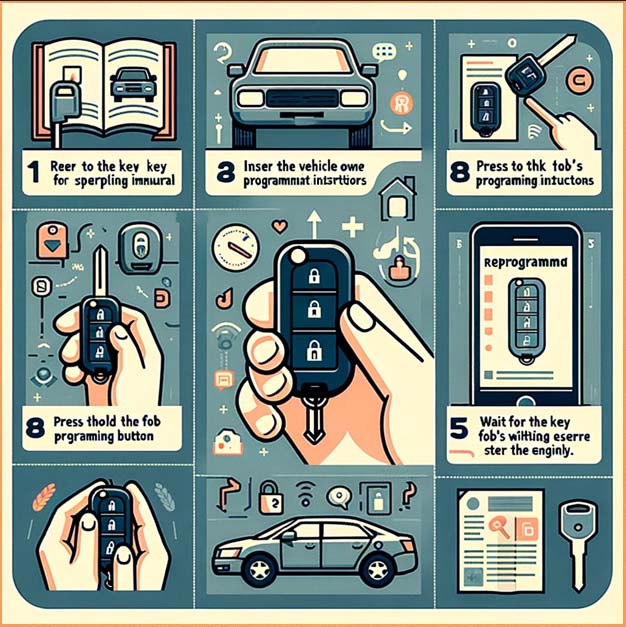“How much does it cost to program a Key Fob” can vary widely depending on several factors, including the make and model of your vehicle, the type of Key Fob, whether it’s a straightforward Key Fob or a more complex smart Key, and where you get the service done. Here are some general guidelines on what you might expect to pay:
How much does it cost to program a Key FOB

•Basic cost to program a Key Fob:
For most vehicles, a primary Key Fob replacement and programming can range from $50 to $100 at a locksmith. Dealerships might charge more, typically from $100 to $200, because of the OEM (Original Equipment Manufacturer) parts.
•Smart Key cost to program a Key Fob:
The cost can be significantly higher for vehicles that use smart Keys, which include additional technology for Keyless entry and Ignition. You can expect to pay anywhere from $200 to $600 for a smart Key replacement and programming at a dealership. Some luxury vehicles may even exceed this range.
• Aftermarket cost to program a Key Fob:
Aftermarket Key Fobs are generally less expensive than OEM parts and can be a cost-effective option. However, quality varies, and they still need to be programmed, costing an additional $50 to $100.
•Locksmith Services cost to program a Key Fob:
Automotive locksmiths can sometimes provide more competitive pricing for Key Fob programming and offer the convenience of mobile services. They typically charge between $50 and $200, depending on the complexity of the Key Fob.
•Additional cost to program a Key Fob:
There may be additional costs involved if your vehicle needs to be towed to the dealership or if there are other issues with the vehicle’s locking system that need to be addressed.
It’s essential to get quotes from several sources, including your local dealership and automotive locksmiths for How much does it cost to program a Key FOB, to find the best price and service for your needs. Remember that while aftermarket and third-party services may offer a lower upfront cost, using OEM parts and services provided by authorized dealerships can ensure compatibility and might be required to maintain your vehicle’s warranty.
You can also find in this article about Key Fob Programming, how to reprogram key fob, why Key Fob malfunctions, and the and working mechanism of Key Fob.
How To Program a Key Fob – General Easy Steps
Programming a Key Fob typically involves a series of steps that can vary greatly depending on the make and model of the vehicle. However, some general steps often apply across different cars. Below is a simplified overview of a typical Key Fob programming process. Remember, it’s always best to consult the vehicle’s manual or a professional for specific instructions related to your car.

General Steps for how to program a key fob
Gather all Key Fobs:
If you have more than one Fob for your vehicle, make sure you have them all available, as some programming sequences will reset all Fobs, and they will all need to be programmed simultaneously.
Enter your vehicle:
Get into the driver’s seat with closed doors. Ensure all doors, the trunk, and, if applicable, the hood is closed.
Turn on the Ignition:
Insert the Key into the Ignition and turn it to the “On” position, but do not start the engine. In vehicles with push-button starts, pressing the start button without depressing the brake pedal may activate the “On” mode.
Activation sequence:
Perform the specific activation sequence for entering programming mode. It often involves actions, such as turning the Ignition off and on multiple times within a few seconds, pressing certain vehicle buttons, or combining these actions. The specific sequence will depend on the vehicle’s make and model.
Program the Fob:
Once in programming mode, you may need to press a button on the Key Fob or perform a specific action with the Fob and the vehicle. For some vehicles, the locks will cycle (lock and unlock) to indicate the vehicle is in programming mode and the Key Fob is recognized.
Exiting programming mode:
After the Fob is programmed, turn off the Ignition or perform the required action to exit programming mode. Again, this can vary by vehicle.
Test the Fob:
Once you have completed the programming, test the Key Fob to ensure it operates as expected. Check all functions: lock, unlock, panic, trunk release, etc.
Repeat for additional Fobs:
If you have more than one Fob to program, repeat the necessary steps for each Fob within the same programming session (if applicable).
Important Considerations
Vehicle-specific instructions:
These are generalized steps. The exact procedure can vary significantly. Some vehicles may require a diagnostic tool or a sequence involving more complex steps.
Professional assistance:
If you’re uncomfortable with these steps, it might be best to seek professional help. Some newer vehicles have security features that require dealer or locksmith programming.
Battery replacement:
Ensure your Key Fob battery is fresh, as a weak battery can cause programming to fail.
Before attempting to program your Key Fob, you must check your vehicle’s owner’s manual or contact your dealership for the precise steps required for your specific vehicle. Some newer models may have more complex systems that only professionals can program.
Additional Tips
If the above steps do not work, your vehicle’s model requires dealer or locksmith programming. It’s especially true for newer models or if the car’s programming has altered the sequence.
Some models may have slight variations in the programming sequence or require additional steps.
how to reprogram key fob
how to reprogram key fob can vary significantly depending on the vehicle’s make, model, and year. While some cars allow owners to reprogram Key Fobs using specific steps, others may require specialized equipment available only at dealerships or automotive locksmiths. Below, I’ll outline a generic step-by-step guide covering a broad Key Fob reprogramming approach. Please consult your vehicle’s owner’s manual or contact a professional for specific instructions tailored to your car.

Step-by-Step Guide to how to reprogram key fob
Step 1: Check Your Vehicle’s Requirements
- Research your specific vehicle’s reprogramming process, as it can vary widely. Some manufacturers provide instructions in the owner’s manual or online.
Step 2: Gather All Key Fobs
- If you have more than one Key Fob for your vehicle, bring it all, as most vehicles will require reprogramming all Fobs simultaneously.
Step 3: Enter Programming Mode
- Enter your vehicle and close all doors.
- Insert the Key into the Ignition (or have it inside the vehicle if it has a push-button start) and turn it to the “On” position without starting the engine.
- Follow the specific procedure to enter programming mode. It often involves turning the Ignition on and off multiple times, pressing door buttons, or performing other vehicle-specific actions within a short time frame.
Step 4: Program the Key Fob
- Once in programming mode (often indicated by a change in dashboard lights or a specific sound), press the button on the Key Fob to perform its programming. Some vehicles require pressing particular buttons on the Fob in sequence.
- The vehicle may respond with flashing lights or a sound to indicate the Key Fob is programmed.
Step 5: Exit Programming Mode
- Turn off the Ignition or follow your vehicle’s steps to exit programming mode. It might involve turning the Ignition on and off again, closing and opening the door, or other actions.
Step 6: Test the Key Fob
- Test every button on the Key Fob to ensure it performs its intended function (lock, unlock, panic, trunk release, etc.).
- If the Fob doesn’t work, repeat the programming steps or consult a professional for advice.
Step 7: Program Additional Key Fobs
- If you have additional Fobs, repeat the programming steps for each one within the same session, as some vehicles reset all Fobs once they enter programming mode.
Additional Tips
- Battery: Ensure the Key Fob battery is fresh, as a low battery can prevent successful programming.
- Owner’s Manual: Always consult the owner’s manual for the exact programming steps, as this guide is generic and might not apply to all vehicles.
- Professional Help: If you need help to program the Fob yourself or if your vehicle requires special equipment, consider getting help from a dealership or an automotive locksmith with the necessary tools and expertise.
This guide provides a generalized approach because of the variety of vehicle-specific procedures. Refer to your vehicle’s manual or contact your dealership for accurate and detailed instructions. Some modern cars have highly secure systems that are only user-programmable with specialized equipment.
FAQs
What is the working mechanism behind a Key Fob?
A Key Fob uses radio frequency (RF) communication and, in many cases, cryptographic algorithms to ensure security. Here’s a simplified breakdown of its working mechanism:
- Radio Frequency Communication: Key Fobs communicate with the car’s onboard computer system via radio waves. Each Key Fob is programmed to emit a unique signal or code the car recognizes. Pressing a button on the Key Fob sends a specific radio signal to the vehicle.
- Identification and Authentication: When the car receives this signal, its onboard computer checks the signals against stored codes. If the received signal matches one of the stored codes, the vehicle performs the requested action, such as unlocking the doors, locking them, or starting the engine.
- Encryption: Modern Key Fobs use rolling code encryption to prevent unauthorized copying of the Fob’s signal. Each time the Fob is used, it generates a new code based on an algorithm that both the Key Fob and the car’s computer system understand. It means even if a thief intercepts the code, it will be useless for future attempts because the vehicle will expect a new code.
- Frequency: Key Fobs typically operate on specific radio frequency bands. Standard frequencies in the United States include 315 MHz and 433 MHz, but the frequency can vary by country due to regulatory differences. Some modern cars use NFC (Near Field Communication) for Keyless entry systems, allowing communication over short distances.
- Components: A Key Fob consists of a microcontroller with programmed firmware that controls its functions, a radio frequency transmitter for sending signals, a battery to provide power, and sometimes a small amount of memory to store the encryption Keys and codes.
Conclusion
Several Key factors influence this variance: the type of vehicle, the specific requirements of the Key Fob programming or reprogramming, the reasons behind Key Fob malfunctions, and how often such issues might arise. The costs can range from a relatively modest fee for straightforward reprogramming at a local locksmith to a more substantial outlay for complex programming needs at a dealership, especially for advanced Key systems.
Understanding why Key Fobs malfunction—whether due to battery failure, damage, or technical glitches—can help owners anticipate potential issues and act proactively.
In navigating these decisions, we recommend conducting thorough research, seeking multiple quotes, and considering the value of investing in spare Key Fobs to mitigate future emergencies. Ultimately, while the initial expense might seem daunting, a fully functional Key Fob’s security, convenience, and peace of mind are invaluable.

